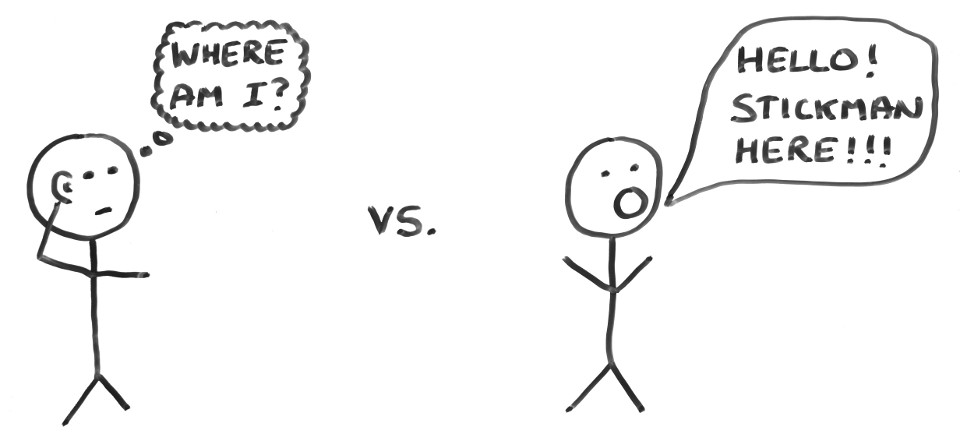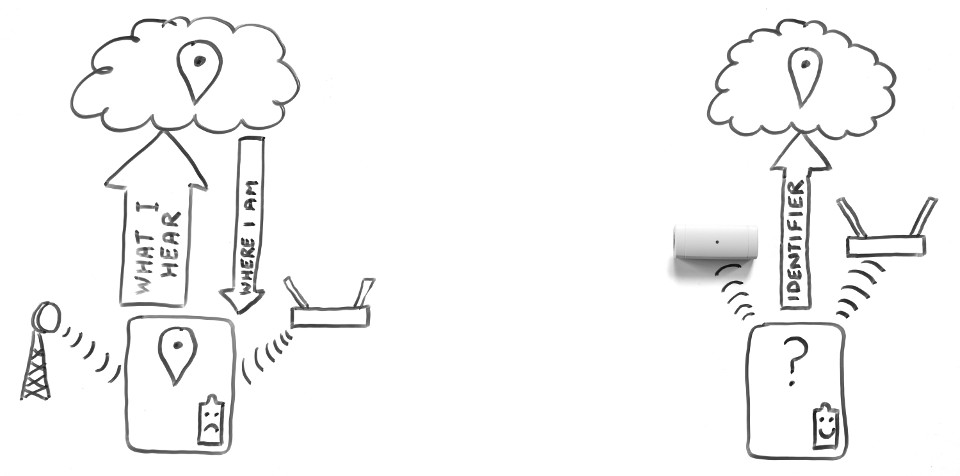
It comes as a surprise to many that indoor location is a core feature of reelyActive. “Isn’t that a solved problem?” The short answer is no. A sufficiently accurate, low-energy (battery-friendly) solution that makes use of an existing, ubiquitous infrastructure simply does not exist today. The intent of this blog post is to familiarize the reader with the basic mechanics of radio location to better understand the inherent challenges, and to clarify the reelyActive approach.
Listen or Speak?
Imagine you suddenly find yourself in an unknown place and it’s pitch black. You can’t see where you are, but it’s important that you find out. Consider the following two options:
- you listen to decipher your location based on the unique sound environment
- you shout out your name hoping that someone is listening, understands and locates you
Essentially, these represent the two common and fundamentally different options in indoor location. Do you expend a lot of energy listening? Do you simply shout out your name and hope someone else figures it out? In either case, your chances are best only when there are a lot of sounds or people listening nearby.
Listen Smart Devices
The smart device is well suited to the listening model. It hears WiFi routers and cell towers in range (indoors, it struggles to hear GPS satellites, so we’ll exclude this technology from the discussion). Since routers and towers are uniquely identifiable, by knowing their fixed locations, it’s possible to estimate the device location based on their signal strength and identity.
Information about radio infrastructure location and identity, being subject to continuous update, is centrally stored in the cloud. So the smart device must tell the cloud what it hears before its location can be determined. If the cloud responds to the smart device, then both know the current location and the device is said to be “location aware”. See the diagram on the left below.

Speak RFID
Active Radio Frequency IDentification (Active RFID) devices are well suited to the speaking model. Active RFID devices transmit their unique identifier periodically and rely on nearby infrastructure to estimate their location. As long as there are infrastructure nodes that hear the transmission, given their fixed locations, it’s possible to estimate the location based on the strength of the signal received at each. Assuming that the infrastructure nodes are Internet-connected, the cloud may calculate the location of the identifying device, which, in this case, is not location aware. See the diagram on the right above.
Listen vs. Speak
Today, neither approach is perfect. Here’s how the advantages play out:
- the listen approach enjoys far greater infrastructure prevalence (WiFi and cellular)
- the listen approach empowers the device user and service provider with location information
- the speak approach is far better suited to inexpensive, low-power devices
- the speak approach requires fewer, shorter radio transmissions in a single direction
- the speak approach also empowers the infrastructure provider with location information
The speak approach currently suffers from a major shortcoming: the lack of an accepted global standard for low-power radio communication. Standards such as Bluetooth Low Energy, ZigBee and Low-Power WiFi have yet to cross the critical adoption threshold.
Regardless of approach, the accuracy of any location estimate is generally proportional to the number of infrastructure nodes in range and their proximity, and is represented as coordinates or as a pinpoint on a map.
The reelyActive Radio Location Approach
We favour the speak approach, overcoming its current disadvantages by creating an accessible infrastructure that supports both current and emerging low-power wireless standards. The location information in our cloud may be consumed by anyone or anything anywhere with the appropriate access rights.
However, unlike most systems which rely on triangulation to locate based on coordinates, reelyActive is instead about semantic location at points of interest. This is achieved by simply installing a cost-effective reelceiver at each point of interest and providing a meaningful semantic label. As a result, for any device which can actively transmit its identity, location would be available via our API as in the following examples:
- IV pump #4 is in room 303
- Carmen’s car just entered parking space #78
- Sam’s smartphone is standing in front of the pasta sauce display
- The temperature of the fish in loading bay 3 is 4°C
Summary
Pending the ubiquitous deployment of an appropriate radio infrastructure, indoor location will continue to be a hotbed of innovation. While the technique of listening and identifying the radio signature of an environment is prevalent and provides reasonable accuracy for smart devices today, the growing number of low-power connected devices of the Internet of Things will instead require an infrastructure that identifies, senses and locates by itself listening to those devices.
Comments
5 responses to “Radio location demystified”
[…] this year we blogged about the two approaches to radio location. For the reasons cited, we have taken the opposite approach to the companies building beacons, […]
LikeLike
[…] it listens for WiFi access points and GPS satellites to determine its location (see our blog post: Radio location demystified). Since GPS is poorly received by smartphones indoors, and WiFi was never designed for indoor […]
LikeLike
[…] The combination of smartphones and connected lighting promises accurate location via beacons, WiFi, computer vision, magnetics, inertial and visible light communication (VLC). Curiously excluded from the list, however, was Bluetooth as a real-time location system (RTLS), essentially beacons in reverse. […]
LikeLike
[…] the ones we carry and wear, to be identified and tracked throughout a space. This is the inverse (literally!) of what Gimbal and almost every other mobile-focused company is doing today with […]
LikeLike
[…] The combination of smartphones and connected lighting promises accurate location via beacons, WiFi, computer vision, magnetics, inertial and visible light communication (VLC). Curiously excluded from the list, however, was Bluetooth as a real-time location system (RTLS), essentially beacons in reverse. […]
LikeLike